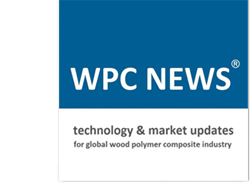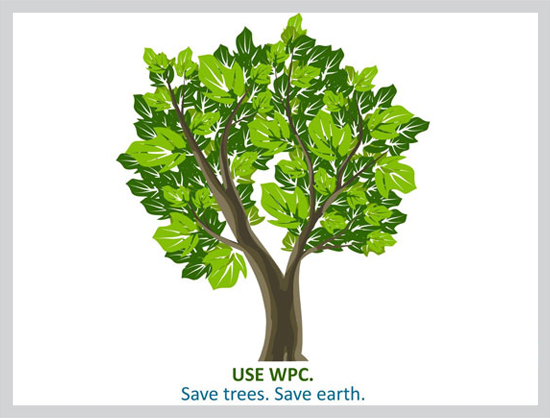Mr. Hardik Panchal, CEO, Hardy Smith, Ahmedabad
1. Tell us about yourself.
Mr. Hardik Panchal is the CEO and promoter of Hardy Smith. Hardy Smith is a turnkey project supplier organisation into Wood plastic composite sector, providing Plant & Machinery, Formulation techniques and marketing support to the WPC sector in India and other countries. Hardy Smith has business cooperation with Battenfeld-cincinnati, Austria for WPC technology.
Mr. Panchal is a polymer technocrat from L D College of Engineering, Ahmedabad and MBA from Ahmedabad University. He has been working for the wood and allied industry since more than a decade now. He has played a vital role in promoting subjects like Particle board technology, Medium density fibre board technology, HPL making technology and Modular furniture making technologies. Wood based panel technology has been a master domain for him. He has worked on Wood waste and agriculture waste based thermoset polymers. Techno commercial Projects and application development for wood panels has been a key area of his working.
WPC is the focused sector for Mr. Panchal since more than 5 years now. He has been instrumental in developing the WPC markets in India. Hardy Smith is the leadership and only company in India nurturing the WPC sector with their efforts for awareness, education, technology & equipments supply. Natural fibre polymer composites based on PVC and PP are the key areas for the company including Extrusion, Injection moulding and Compression moulding techniques. WPC CENTRE is an application centre established by HARDY SMITH at Ahmedabad. Here WPC panels are converted into doors and furniture, replacing plywood and wood.
2. What is wood polymer composite (WPC), and what makes it so popular nowadays?
Wood polymer composite is a product made with a composition of natural fiber and polymer. Here natural fibers can be any wood fiber (in powder form usually) or agriculture waste (rice husk, bagasse, wheat straw etc.). WPC is typically a polymer product made with Poly vinyl chloride, Poly propylene or Poly ethylene kind of plastics. Natural fibers are used as filler materials to the polymer cells. Globally WPC Decking is a very popular subject for exterior applications in developed countries like US, Europe, Japan, Australia and China. China and India has made a new subject famous as WPC board. India is becoming a focus point for WPC manufacturing globally with more than 40 lines installed for WPC boards and WPC decking, nationwide. As a city Ahmedabad from Gujarat state is taking a leadership, today. The entire development of the WPC market is being done on the agenda of giving a life time and quality product for Indian homes, offices, hotels, hospitals and schools. WPC in general can withstand spontaneously against moisture and termite because of its polymeric structure. Today major population of India-taking from slum area to posh villas- are suffering from termite attacks and moisture problems. Natural wood cannot be afforded by 88% of population today. Recent trend in building material and furniture industries is going quite positive with newer materials. Mindset of today’s generation is open, exhaustive and well oriented towards qualitative, innovative, clean & green and value for money products. WPC fits best to their requirements. WPC boards are easy to manufacture in compare to other wood panels. It needs smaller investment with controlled size of project. It is enjoying the advantage of ‘labor less production’, almost. Carpenters are becoming handy with this product because of its easiest solvent joinery systems. It reduces individual labor and makes the furniture making very fast. It reduces the overall material consumption too. Thus, Indian local customer is rapidly accepting this material and it is in a good demand today. As a result Indian wood panel leader like CENTURY PLY also has jumped into WPC boards market, recently.
3. What is the utility of WPC in interior and exterior applications?
WPC in interiors is widely used for Doors, Modular kitchen carcasses, shutters, shelves, kitchen trays, bathroom vanities, wardrobes, office furniture, book shelves, toilet cubicles, counters, partitioning systems, gift articles, containers and utilities for home, hotels and hospitals.
In Exterior WPC is available for exterior wall cladding, exterior flooring (decking), Planks for fencing, Planks for outdoor furniture like restaurant tables, garden furniture, terrace furniture, swimming pool areas and many more.
4. What peculiarities of WPC make it a suitable material in the making of modular kitchens?
a. Water proof
b. Termite proof
c. Fungus proof
d. Germs proof
e. Mosquitoes and cockroaches remains away because of a smell of chlorine
f. Best fit for high water utility area
g. Best use in Water clogged areas
h. Best use with Wet floors
i. No seepage transfer from wall to furniture
j. Keeps the internal environment of closed carcass ‘fresh’ in compare to plywood
k. Faster installation
l. Use without HPL in carcasses (fittest application)
m. Easy to clean
n. Shutters can be applied with HPL, PU and Duco.
o. Moulded shutters also can be made.
5. What are the advantages of WPC over natural wood in today’s time?
Indian wood industry is suffering from following problems today:
a. Scarcity of wood
b. Licensing system by Indian government for wood based industry – to save forests
c. Tree plantations – not in social practice
d. Loosing tree covers day by day
e. Dependency on imports
f. No qualified manpower available for plant operations, formulations
g. Old edge consultants with limited knowledge bank
h. Very limited government institutes providing courses on ‘wood technology’
i. No professional institutions and no quality engineers
WPC overcomes all above problems as follows:
a. Saves virgin wood/trees
b. No licensing for plastic processing
c. Uses agriculture wastes also
d. Protecting tree covers, as it is.
e. No dependency on imports. Players like Reliance, DCW, Finolex, Formosa, Sanmar are supplying raw material from their Indian projects only.
f. Professional engineers, ITI graduates and Diploma holders are available
g. New edge entrepreneurs and multinational technology companies are there
h. Many professional institutions including IITs has ‘polymer engineering’ as a main stream course.
6. Can WPC replace other materials like MDF and particle boards, plywood, etc.?
WPC can replace all the panel materials including natural wood, MDF, Particle boards, Plywood as well as regular flush doors and block boards. It can be stained, painted, PU coated, HPL laminated, Sandwich pressed, PVC foil laminated, Embossed, Moulded and joined similarly like wood panels and wood.
It doesn’t have emission issues those happen in wood panels due to binders like Urea Formaldehyde/Melamine Formaldehyde/Phenol Formaldehyde.
WPC Reduces consumption of High pressure laminates, thus reduces paper consumption and by that trees!
i. 1 sqft wood panel = 2 sqft HPL,
ii. Per day 100,000 panels consumed, thus 3200,000 sqft of HPL consumed
iii. 10,000 CFT of wood per day for HPL can be saved by using WPC
7. There is a massive growth in the Indian modular kitchen market in recent decades. How do you look at this trend in terms of manufacturing industry?
India is becoming the fastest growing market for readymade modular kitchens now. We can observe the entry of prominent multinational players like Siemens, Hacker, Nolte etc. Indian lower middle class is being loaded with more responsibilities because of fluctuating economy. Thus old practices of working with local carpenters are becoming out of date and readymade kitchens and furniture are entering at a very fast pace. Lucrative surface options and material options are making Kitchen engineering very interesting.
8. Do you feel there is an equally big market for WPC in India already for making kitchens?
Definitely yes. As explained earlier about Kitchen Carcass, WPC is becoming widely popular in two ways. It is replacing conventional plywood and MDF panels (laminated with HPL or Deco paint) with direct WPC PVC panels. It also replaces the low cost/cheap market of PVC hollow section kitchens. WPC PVC is perfectly available for lower middle class and middle class markets and it is available for premium segments too.
9. How can the kitchen designs be made cost-effective in terms of material selection?
We recommend WPC for kitchen carcass application as most cost effective material. Any carcass either for kitchen or wardrobe or office – needs both side laminations with HPL in usual case. It consumes adhesive and labor too. Against WPC panels can be directly fitted without any lamination. Panels can be available in white, wood color and any other customized color too. Carpenter can directly fix the joints with Solvent system and it doesn’t required screws at times.
WPC is 100% recyclable material and it is always carrying its resell price, at any point of time in future. Companies are offering buy back also with WPC panel made furniture.
10. What plans do you have to generate awareness about WPC?
HARDY SMITH from WPC CENTRE is spreading awareness by practical presentation of furniture making to Architects, Interiors and Institutional buyers. Company has showcased full size demonstration of modular kitchens, wardrobes, bookshelves, bathroom vanities, office furniture, Doors, Door frames, Ceiling panels, Interior wall cladding etc at WPC CENTRE. Company is supplying finished products to its pan India network with reasonable price. This leads to a good market reach and reactive positive results about the subject. Company is providing free samples to the interested end users.
We are foraying into technology supply with some new global tie ups in WPC sector. Today we are representing Indian on international platform in a leadership role for promoting the WPC.

